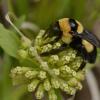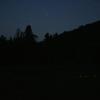
Hylaeus anthracinus is a coastal bee endemic to the islands of Oahu, Molokai, Kahoolawe, Maui, Hawaii, and formerly Lanai in Hawaii. It is distinguished by the single large facial mark, sometimes filling the entire area below the antennae. Although it can sometimes be found in moderate numbers, habitat destruction has caused its range to contract significantly.
Males
Face marks yellow, consisting of a single large spot; clypeus always fully yellow, color of paraocular areas varying from a narrow yellow strip along the clypeus to almost completely filling in the area below the antennae. Hairs of abdominal apex black, erect.
Females
Entirely black, lacking coloration; mandibles tridentate, a trait shared only with the sister species H. flavifrons. Hylaeus anthracinus is sister to H. flavifrons but otherwise not closely related to other Hawaiian species. Superficially it resembles species of the difficilis group, with the single, central facial mark and very narrow process of the 8th sternum in the male.However, it does not have the synapomorphies of that group (narrow, pubescent scape, appressed brown hairs on the apex of the abdomen), and resembles the wood-nesting species in the black abdominal hairs and dilated scape.
Taxonomic Status
Hylaeus anthracinus was described as Prosopis anthracina by F. Smith (1853), and transferred to the new genus Nesoprosopis by Perkins (1899). Nesoprosopis was reduced to a subgenus of Hylaeus by Meade-Waldo (1923). The most recent taxonomic treatment was Daly and Magnacca (2003).
Hylaeus anthracinus is generally found in coastal strand. Like other coastal species, it can also occasionally be found at higher elevations in dry forest. Nesting habits are unknown; it may nest in stems of coastal shrubs. Flower records include Scaevola sericea (naupaka), Sida fallax (ilima), Chamaesyce spp. (akoko), Argemone glauca (pua kala), Myoporum sandwicense (naio), and Tournefortia argentea (tree heliotrope).
Hylaeus anthracinus is apparently restricted to small patches of habitat on each island. The largest area is probably on Molokai, where an area of sand dunes stretching from Moomomi to Kalaupapa may support a large population. Elsewhere it is found at Kaena Point on Oahu; Pali o Kalapakea on Kahoolawe; Kanaio and Manawainui on Maui; and South Point and Ooma on Hawaii. Additional sites may exist, but it is likely that they too will be small areas.
Xerces Red List Status: Critically Imperiled
Other Rankings:
Canada – Species at Risk Act: N/A
Canada – provincial status: N/A
Mexico: N/A
USA – Endangered Species Act: Species of Concern
USA – state status: HI: Species of Concern
NatureServe: GNR
IUCN Red List: N/A
This species was found widely in the early period of Hawaiian insect collecting (1892- 1930). It is now restricted to small, potentially vulnerable populations. Originally, U.S. Federal listings of rare and endangered species classed H. anthracinus as a “Category 2” Candidate Species about which more information was needed before it could be considered for listing. This status was based on recognition that Hawaiian bees in general were becoming rarer and little was known about their conservation status. Data were never gathered to document whether or not this species should be proposed for listing. It is currently considered to be a “Species of Concern” or a “Special Status Species” by the U.S. Fish and Wildlife Service and the Hawaii Division of Forestry and Wildlife.
The biggest threat to H. anthracinus is habitat loss. Although the species can be found in relative abundance in some areas, native coastal strand vegetation is now extremely rare. Perkins found H. anthracinus even in Honolulu and Waikiki, but development and introduced plants have severely reduced available habitat. Ants may also negatively affect this species. Unlike other coastal species, it is rarely found in inland dry forest.
Known populations of H. anthracinus on Oahu, Molokai, Maui, and Kahoolawe are protected under the auspices of the State of Hawaii, the National Park Service, and the Nature Conservancy. Another Maui population is in an area undesirable for development, though it may be vulnerable to encroachment by invasive plants. The population at Ooma on Hawaii may be at risk from nearby development, and at South Point they may be vulnerable to vegetation damage by visitors. All sites are susceptible to fire. Maintenance of remaining habitat is the highest priority. Research is needed in order to determine life history requirements, including nest sites and pollen requirements, and to find additional populations.
Daly, H. V., and K. N. Magnacca. 2003. Insects of Hawaii, Vol. 17: Hawaiian Hylaeus (Nesoprosopis) Bees (Hymenoptera: Apoidea). University of Hawaii Press, Honolulu. 234 pp.
Smith, F. 1853. Catalogue of hymenopterous insects in the collection of the British Museum. Part I. Andrenidae and Apidae. Printed by order of the Trustees, London. 197 pp.
Meade-Waldo, G. 1923. Hymenoptera, fam. Apidae, subfam. Prosopidae, fasc. 181. Pp. 1-45 in P. Wytsman (ed.), Genera Insectorum. L. Desmet-Verteneuil, Brussels.
Perkins, R. C. L. 1899. Hymenoptera, Aculeata. Pp. 1-115 in D. Sharp (ed.), Fauna Hawaiiensis, Vol. 1. Cambridge University Press, Cambridge, United Kingdom.
Citation
Magnacca, K. N. 2005. Species Profile: Hylaeus anthracinus. In Shepherd, M. D., D. M. Vaughan, and S. H. Black (Eds). Red List of Pollinator Insects of North America. CD-ROM Version 1 (May 2005). Portland, OR: The Xerces Society for Invertebrate Conservation
Profile prepared by Karl Magnacca, USGS-BRD, Kilauea Field Station





